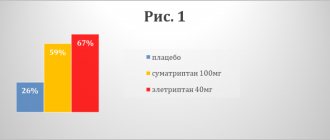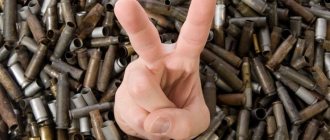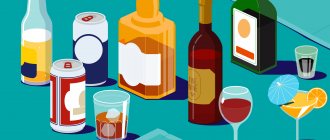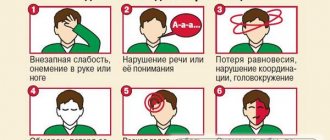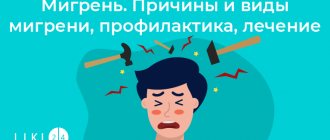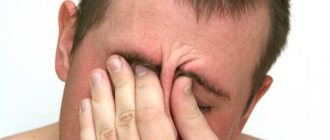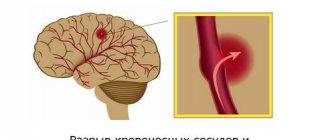Now the seasons are changing, and many people complain of headaches, which they associate with the change in weather.
According to a Eurohead study, 50% of patients suffering from headaches tend to blame the “heavenly office” for their problems.
In most cases, such “weather” pain is a migraine. The second most common type of headache is tension headache. How can you tell them apart?
Tension pain is of mild or moderate intensity, it is evenly distributed throughout the head and is similar to compression. For migraines, throbbing or pressing pain is typical. It usually covers half of the head and is felt in the forehead, temple, and around the eyes. A migraine attack is often accompanied by additional symptoms - nausea, increased sensitivity to bright lights (photophobia), or loud sounds (phonophobia), or smells (osmophobia). Vomiting and dizziness may also occur. During an attack, physical activity worsens the condition; it is better for the patient to be in a quiet, dark room. The attack lasts from 3–4 hours to 3 days (on average 20 hours).
My legs give me no rest. How does flat feet lead to headaches? More details
Is the weather to blame?
“Changes in weather conditions are one of the provoking factors of migraine, but not the only one (see infographic), explains a neurologist at the National Medical and Surgical Center. Pirogova Vera Blokhina . — According to statistics, 50% of people suffer from systematic weather-related headaches. But the specific provocateur is different for each patient: for some, the headache begins due to changes in atmospheric pressure, for others - from temperature changes, in others - due to heat and excess sunlight (solar migraine), in others - from cold weather (cold migraine), etc. Neurologists advise such patients to keep a headache diary, which will help identify individual factors that provoke and alleviate such pain.”
Click to enlarge
Is it possible to prevent headaches?
To prevent pain caused by muscle tone, neck exercises help. Alexey Malkov recommends the Shishonin method
- these are simple exercises that can be found on the Internet. They take about 20 minutes to complete. According to the doctor, they cannot cause harm.
Also from the recommendations: sleeping on an orthopedic pillow ,
regular
massage of the cervical-collar area
.
For those who work at a computer, two more tips: get distracted every two hours and do short exercises for your neck ,
and once a week try to change the position of the screen (move from the left to the right side of the table and back). The latter will prevent you from developing a “chronically forced posture.”
Additionally, the neurologist advises avoiding excessive consumption of caffeine and alcohol, and quitting smoking to reduce the risk of vascular pathology. If headaches are chronic, you can take magnesium
(courses twice a year, according to the instructions), vegetative correctors and venotonics for prevention (also according to the instructions).
You can make an appointment with Alexey Malkov or another neurologist by calling the center: +375 29 311-88-44 ; +375 33 311-01-44 ; +375 17 299-99-92 .
Or through the online registration form
on the website.
How is the diagnosis made?
Headache is a subjective sensation that is not recorded by tests and studies. Therefore, the diagnosis is made based on the patient’s complaints, medical history, and additional examination (electroencephalogram of the brain, ultrasound of neck vessels, MRI and CT) may be required to exclude the so-called secondary headache - it occurs with brain tumors, hemorrhage, aneurysm, etc. d. Migraine is often confused with pain in such diseases, but they need to be distinguished - this is important for treatment.
Tension headache
Tension headache (TTH) is a primary headache, one of the most common types of headaches (along with migraine). Primary pain is called when itself is the main disease
The article was prepared by our neurologist Pavel Dmitrievich Kovzelev.
Frequency of occurrence
all people have experienced headaches in one way or another , although official statistics say that this is only 90% of the total.
Tension headache (TTH) is a primary headache, one of the most common types of headaches (along with migraine). Primary pain is called when itself is the main disease.
How does a headache hurt with tension headache?
- most often it hurts moderately, with weak or medium intensity.
- more often it is bilateral pain.
- the pain has the characteristics of squeezing or pressing: “Doctor, I have the feeling that they put a helmet on me or tied it with a hoop.”
— The duration of the attack is from 20 minutes to several days. The frightening fact is that when a headache lasts, for example, seven days in a row, people do not know what to do about it. Especially if this situation happened for the first time.
- Nausea or vomiting is not typical, although it does occur occasionally.
- Everyday physical activity is most often possible and does not cause increased pain.
Tension headaches can be diagnosed when all other causes of headaches have been excluded. It is necessary to correlate the patient’s complaints and medical history with the criteria for diagnosis. We use classification 3 (the most recent) of the European Headache Society.
Mechanisms of HDN
Mechanisms of headache development:
- Overstrain of neck and head muscles
- Psycho-emotional stress
- Decreased pain threshold and inadequate functioning of the body's anti-pain system.
Points one and two may seem trivial to you, perhaps even somewhat hackneyed and hackneyed, but in fact these are real basic mechanisms . Our head, namely the scalp, has no muscles and is represented by connective tissue. When the neck muscles are overstrained, they simply pull back , causing pain.
Stress triggers this mechanism, because... the neck muscles are only partially subject to normal, conscious motor control. Involuntary muscle contractions occur under stress. This is similar to the reaction of a cat when it sees a dog - the muscles tense, the cat bends in an arc . But unlike animals, people cannot relax and return to their previous state in a few minutes.
The situation with chronic, long-term psycho-emotional overstrain greatly complicates the situation.
Very often, tension-type headache is combined with anxiety and depressive disorders and both conditions need to be treated.
All this forms a certain “lump” of problems, a vicious circle where each link reinforces each other.
Depending on the frequency of attacks, there are 2 types of headache: episodic and chronic. Chronic pain is called when it bothers a person more than 15 days a month . From experience, I will say that people often have headaches 25-30 days a month and many consider this to be the norm. Naturally, this is not so.
How are headaches treated in St. Petersburg, at the Smart Clinic?
The points.
- The most important thing is to establish contact with the person, win them over and use cognitive behavioral therapy (CBT). It is necessary to clarify that HDN is a benign and can be treated . Also, as part of the examination, soft manual techniques, muscle relaxation, and, for one thing, the person himself can be used. Often we can just talk “about life” - not out of idle curiosity, but simply to better understand the patient, how and with what he lives, what level of stress he has, etc.
- Treatment with tablets is effective . This is, perhaps, one of the few diseases when pharmacotherapy actually works at 5 plus levels. It is divided into 2 areas: treatment of an attack of hypertension and prevention of headache . analgesics are used to treat an attack . For prevention antidepressants , because there is a close relationship with the emotional sphere and the work of neurotransmitters. Therapy is also supplemented with b-blockers.
- Non-drug therapy . The position of evidence-based medicine on this issue is at level C, i.e. recommendations from individual communities and experts. For example, depending on the patient and his request, we can use different methods. Sometimes this is shock wave therapy for neck triggers, sometimes reflexology . If a person notices a good effect from a massage , why not include him in treatment? Works especially well for women. The main thing is to help.
All this is number one is : contact and clarification.
Based on what has been said, it becomes clear that a headache appointment cannot last 10-15 minutes. It takes time to understand the problem.
Headache diary.
The process of treating headaches, especially chronic ones, is very long and difficult. Commitment is required from both the doctor and the patient. An objective assessment of the number and severity of headache attacks is a priority . For this purpose, all clinics around the world use the so-called headache diary.
Naturally, we cannot do without it, because such targeted work is always rewarded with understanding on the part of our patients and higher adherence to treatment, and therefore its high effectiveness.
We recommend that all our patients keep such a diary, and those who are just planning to come for an appointment start keeping it on their own, at least for 1-2 weeks.
You can download it and print it by simply clicking on the button below absolutely free of charge.
Why are MRI and ultrasound of neck vessels not effective for diagnosing hypertension?
(In most cases)
Because we cannot find the real causes of headaches there. These methods can be used to rule out any secondary cause of headache. For example, a tumor, stroke, severe venous decirculation, etc. It is advisable to carry out all studies after consultation with a doctor.
Droppers and “vascular” drugs, various nootropics/Mexidols and other fantasies of Russian pharmaceutical companies are not effective, because The cause of headache is not in the blood vessels. Their effectiveness is placebo level.
My resume
Basic principles of treatment:
- Don't endure pain. Stop an attack. Keep a diary. Work on prevention and strive to prevent headaches from becoming chronic. Chronic pain is much more difficult to deal with.
- Treat chronic pain with real drugs such as painkillers, antidepressants, b-blockers, anticonvulsants under the supervision of a doctor.
- Combine treatment with non-drug therapies.
Take care of yourself.
I hope your head will hurt less after reading this text. But if anything happens, our clinic is ready to help you.
What if it's cancer?
With frequent headaches, many people think about brain cancer. “Headache is one of the first signs of brain tumors, both benign and malignant,” says the chief physician of the Research Institute of Clinical and Experimental Radiology, National Medical Research Center of Oncology. Blokhina Ekaterina Kobyakova . - It can be caused by increased pressure in the cranial cavity and compression of adjacent tissues. The main difference between pain caused by a tumor is its combination with other symptoms (impaired balance and coordination of movements, visual disturbances, epileptic seizures, vomiting). CT and MRI of the brain help in making a diagnosis.”
Migraine or stroke?
“Ischemic stroke cannot be confused with migraine pain,” explains neurologist Igor Matsokin . “But the symptoms of some forms of hemorrhagic stroke (bleeding in the brain) may resemble it. But there are fundamental differences. With migraine, the headache can usually be relieved or weakened with regular painkillers. And with a stroke, pain occurs suddenly and is necessarily accompanied by speech, vision, hearing, and paralysis. Plus, all these symptoms are steadily progressing.”
What to do if you have a headache?
If you have a headache every day, then there is only one answer to this question - make an appointment with a neurologist. Considering that many serious diseases cause severe headaches, you need to make sure that they are absent.
Of course, there are preventative measures that must be followed at all times. First, change your daily routine, sleep more, go to bed at the same time, try to be outside more or ventilate the room at work. Secondly, give up bad habits and foods, watch your weight. Thirdly, use essential oils; aromatherapy, especially combined with relaxation, can reduce pain. Fourth, use folk remedies: infusions, compresses, decoctions.
All these remedies are auxiliary and simply useful for the body, but real help if you have a headache every day can only be provided by specialists - a neurologist or a neuropathologist.
How to treat?
There are two types of medications used for migraines. Some relieve pain that has already arisen, while others prevent the development of attacks. The latter are prescribed to patients with frequent attacks. Most medications are over-the-counter. But they can only be taken as prescribed by a doctor. Uncontrolled use leads to a special headache, which is more difficult to treat than a regular migraine.
Mysteries of migraine. Why can’t this disease be cured forever? More details

